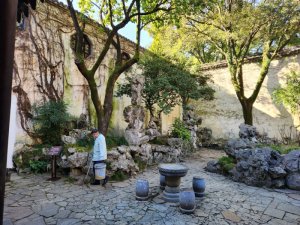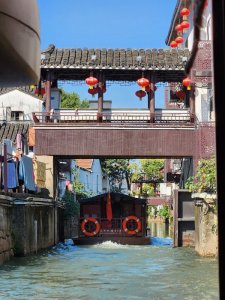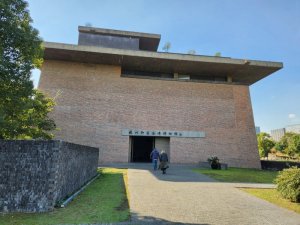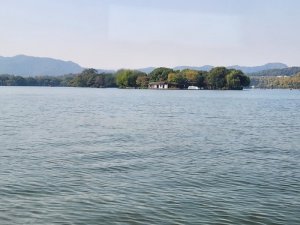
Nicole Anderson explores areas in and around this mega metropolis of captivating Shanghai, China.
Shanghai is recognized as China’s largest city with a population of 26.3 million. Staying at a hotel in central Shanghai and looking out the windows on any side, James and I seriously couldn’t see where the skyscrapers end as we scanned the horizon.
Having just arrived by flight from Chongqing (the actual largest populated region in China with 31 million) we had just completed an amazing cruise through the Yangtze River and 3 Gorges which was a serene experience and very different to the fast-paced city of Shanghai.
Nevertheless, if you are a fan of the outdoors, there are several worthwhile places to visit within just a few hours from Shanghai which are beautiful and fascinating spots that will enrich your visit. Indeed, there are also things that are worth seeing and doing while within Shanghai itself which I will include here as well.
The two main centers some distance from Shanghai that we stayed at to explore were the smaller cities of Suzhou and Hangzhou. We based ourselves in these cities before returning to Shanghai as this would mean less time traveling and more time at these attractions.
Taking in turn in the order of places we visited from Suzhou, Hangzhou and Shanghai, read on to see the highlights of our time in this part of China.
Suzhou
This city of 13 million was our first base, some 600km west of Shanghai.
The Lingering Gardens

Included within UNESCO’s World Heritage List as one of the Classical Gardens of Suzhou, the Lingering Gardens are situated at 338 Liuyuan Road, outside Changmen Gate in Suzhou, Jiangsu Province, and recognized as one of China’s four most famous gardens.

According to UNESCO, the gardens of Suzhou “represent the development of Chinese landscape garden design over more than two thousand years,” and they are the “most refined form” of garden art. Looking at some of the photos taken that day and shown here, perhaps you would agree.

The Lingering Gardens were first built in 1593 during the Ming Dynasty (1368 – 1644) by a retired official named Xu Tai. The garden is a wonderful creation and arrangement of plants, stones, ponds, sculptures, and architectural beauty occupying some 6 meticulously maintained acres.

The garden is divided into four sections: artificial hills in the west, pastoral scenery in the north, hall and pavilion structures in the east, and hills and waters at the center. A winding corridor of over 1,000 meters links them and it was lovely just to take a leisurely walk through the whole area.

These are definitely not Western-style gardens. You will see strangely shaped rocks, disordered landscapes, well-tended bushes, and artificial hills. This is the Chinese way of finding the perfect balance between the human world and nature. According to experts, these gardens represent the aesthetic goals and values that you can find in other art forms such as Chinese landscape painting, calligraphy, and poetry. It was a delight to visit.


Cruising The Grand Canal of China
The city of Suzhou is one of many locations in Asia to be known as ‘The Venice of the East’.
Suzhou has a number of canals and is best known for being bestowed the Venice title from famous explorer, Marco Polo, who visited there in 1276.
He did this because of the extent of the canals and stone bridges in this area.

Significantly though Suzhou’s canals are connected more broadly to a network of canals and river sections to form ‘The Grand Canal of China’. This Grand Canal (or artificially created river) is both the oldest (starting construction 2500 years ago) and longest in the world stretching for some 1776 kms or 1104 mi from Hangzhou to the outskirts of Beijing.

The Grand Canal of China is the only waterway in the country that runs north to south, rather than west to east. Not as famous as The Great Wall of China, this network of canals actually connects the two longest rivers in China: the Yellow River and the Yangtze River.

We journeyed through the narrow Suzhou canals, one of the oldest in the world in traditional boats that were not far off the water. This cruise afforded great views as you plied the waterways observing the historic buildings that are still occupied and traveling under ornate bridges still in use today.

Not surprisingly, the Grand Canal of China overall is another significant UNESCO World Heritage Site. Suzhou is well known as a place to experience the traditional canal cruise where parts of the canal have hardly changed at all for over two thousand years.

Yet you can travel to the modern side of Suzhou close by which has more high-rise buildings and is also a main manufacturing center for many products, including laptops, IT-related goods, and textiles. It’s quite amazing how these areas can exist within the same city of Suzhou and yet be worlds apart.

Suzhou Brick Museum

Having a bit of time to kill before our drive onto Hungzhou, the group we were traveling with took a detour to visit the Suzhou Brick Museum.
Suzhou Imperial Kiln Ruins Park & Museum of Imperial Kiln Brick is located in Xiangcheng District in Suzhou, which is mainly for protecting historical ruins, and displaying cultural relics such as Jin Zhuan (literal translation is Golden Brick) and related cultural impacts.

The information on the process of ancient brickmaking and how this influenced society was very interesting and the displays of architectural buildings and the culture through the ages were so detailed.


I’ve included a few images here to give some idea of this attraction. While I might not have chosen this option as a place to visit as such, I did enjoy the experience.

After going through the main building and surrounding exhibits in the grounds, we then boarded the coach and headed for Hangzhou, some 123 kms to the south taking two hours or so away by road.
Hungzhou
This is a city of 12 million some 163 kms south-west of Shanghai which has so many high standard hotels to book into while you explore the general area.
Meijiawu Tea Village

The Hangzhou region outside of the city is known as the Tea Capital of China and is just a beautifully scenic place. We paid a visit to a Tea House in The Meijiwu Tea Village in the hinterland of West Lake Park, considered as one of the most important Longjing Tea production areas in China.

Hungzhou has long been a major center of tea production in China – the cultivation of the plant here goes back well over 1000 years. Fertile soils, pure water and a pleasant climate combine to produce the region’s famous Longjing – or dragon well – green tea.

Here we had the opportunity to wander through some of the tea plantation, pick and taste some leaves prior to entering the tea house. At the tea house our group was given information on how tea is produced while tasting different teas and of course making purchases to take home.

Aside from the educational aspect of the visit here, the outlook onto the plantation fields and hills was lovely, not to mention how well the gardens within the tea house grounds were. It all made for a very calming and serene atmosphere.

West Lake
Another significant wonder recognized by UNESCO as a World Heritage Site, West Lake is surrounded on three sides by ‘cloud-capped hills’ and on the fourth by the city of Hangzhou.

This place was a real highlight of our trip showcasing the tranquil beauty of China. We arrived a short distance from the lake and walked there and then skirted the shores of the lake where we passed between this gorgeous lake and the architectural beauty of temples and traditional buildings. There were many people there that had come to enjoy the lake also but this area still provided a very peaceful and inspiring atmosphere.


To quote Lonely Planet:
“The very definition of classical beauty in China, West Lake is utterly mesmerising: pagoda-topped hills rise over willow-lined waters as boats drift slowly through a idyll of leisurely charm. Walkways, perfectly positioned benches, parks and gardens around the banks of the lake offer a thousand and one vantage points for visitors to admire the faultless scenery.
Originally a lagoon adjoining the Qiantang River, the lake didn’t come into existence until the 8th century, when the governor of Hangzhou had the marshy expanse dredged. As time passed, the lake’s splendour was gradually cultivated: gardens were planted, pagodas built, and causeways and islands were constructed from dredged silt.”



The cruise we took around the lake gave us even more beautiful views looking back to the shore from the tranquillity of the lake. West Lake itself covers 6.4 sq kms (2.5 mi) with a perimeter of around 15km. It has an average depth of 2.3 meters, the deepest part being around 5 meters and the shallowest being less than a meter. On three sides the lake looks onto numerous pavilions, bridges amidst lovely nature with dozens of hills in the background. While the hills themselves do not exceed 400 meters in height, they appear graceful with unique peaks, rock formations and elegant springs. The other side of the lake looks over to Hangzhou city in the background.

The boat ride was gloriously calm as we glided through the still waters taking in the amazing views and atmosphere and we enjoyed it immensely. It is indeed hard to believe this whole area is just off the large city of Hangzhou.
Captivating Shanghai
Having stayed in Suzhou and Hangzhou we returned to the mega-metropolis of Shanghai to see some places and experience things for which this city is famous.
The Bund
The Bund is perhaps Shanghai’s most iconic sight and is the city’s most famous mile. A symbol of colonial Shanghai, the Bund is lined with legation buildings, banks and hotels in a typical early 19th century architectural style.

The Bund stretches 1.5km on the west bank of Huangpu River. It begins at Waibaidu Bridge in the north and ends at Yan’an Road in the south, which crosses Suzhou Creek. The Bund (also called Waitan) is a representation of Shanghai’s 1920s economic boom, is an incredible contrast to the district of Pudong which sits on the east side of the Huangpu with its countless modern-day skyscrapers.

Shanghai is essentially the financial capital of China with the Bund housing the main buildings as well as a huge statue of a bull close to the main walkway along the Huangpu riverfront. Interestingly this area is also home to one of the richest collections of art deco architecture in the world.

However, the Bund is not all buildings and architecture. The Bund walkway that runs alongside the river facing the Pudong CBD district is very wide, kept so clean and also has a number of lovely plants and greenery in this unique location.

Shopping
Shanghai shopping is just legendary. Shanghai is often referred to as the “Paris of the East” or the “New York of the Orient.” Luxury designer boutiques and shops are found in numerous districts dedicated to retail. Giorgio Armani, Dolce & Gabbana, Cartier, Patek Philippe, Ermenegildo Zegna, Prada, Gucci, Ralph Lauren, you name it, they are all here.



Also, there are several domestic brands available which offer anything from handcrafted silk slippers to porcelain tableware, antiques, and tourist souvenirs. Added to this are so many restaurants offering Chinese and a range of other world cuisines. The range is incredible from really great value food outlets all the way up to world class fine dining options.

Silk Factory and wholesale
Silk and the quality of this beautiful material is synonymous with China. Shanghai has many silk factories which welcome tourists. We went to one which provided interesting detail on the silk creation and manufacturing process.
The knowledgeable guide showed us both the traditional and modern ways of manufacturing silk to the highest standard. The history of silk was quite fascinating and seeing a demonstration of how this was produced firsthand showed how painstaking and laborious this process is. To this day, Shanghai is the major silk export center to the rest of the world.
We then were invited into their showroom where we were able to purchase some wonderful silk products. The range of genuine silk products was quite amazing and obtaining silk from the home of this lovely material was worthwhile.


The Shanghai MagLev Train
Having recently traveled through central China via 2 bullet trains, we were quite intrigued to learn that Shanghai was home to the MagLev Train (the name ‘MagLev’ being the shortened version of the term Magnetic Levitation).
Using the German Transrapid technology, the MagLev is the fastest train in the world. It is capable of a cruising speed of 431 km/h (or 268 mph). This train operated at this unbelievable cruising speed on every trip until May 2021. It then reduced its cruising speed to just over 300 km/h following a serious Maglev accident in Germany. This change in speed effectively makes the Shanghai MagLev travel at the same fast speed as the domestic modern bullet trains. Its record test speed was 501 kph (311 mph), making its entry into the Guinness Book of World Records back in 2003.

Experiencing a trip on the MagLev is not all about speed though. The feeling you have knowing that you are on a train with no wheels being propelled by the power of magnets where the train hovers slightly above the track at such a fast speed is pretty amazing. It is every bit as stable and comfortable as the bullet trains except you are rocketing toward your destination on a pillow of air.

Running on ‘clean energy’, this train is truly environmentally friendly, using half the comparative energy of buses and only a quarter of the energy used by planes, and does not produce any pollution. As these trains don’t touch the railway line, it makes them smoother and quieter than other trains.

The MagLev can not travel on any other track than one designed for this train, the same way that bullet trains can not travel on conventional train tracks. The cost of building this MagLev technology is exorbitant so it is hard to imagine this technology ever becoming mainstream for train travel. The external shape of this train looks distinctly different to either conventional or bullet trains and the interior is every bit as luxurious and well-maintained as the bullet trains. It’s a bit like comparing jet planes to the Concord in that its sleeker, carriages perhaps slightly smaller but classier, and of course considerably faster.
Also known as the Shanghai Transrapid, the Shanghai MagLev Train is the world’s first commercial high-speed MagLev and operates just between two stations. This train travels either east to Longyang Road Station (Shanghai Subway Line 2), or west to Shanghai Pudong International Airport. This is a distance of 30 km (19 mi) which it comfortably does in 8 minutes.

We traveled the Shanghai MagLev train for the sake of experiencing this technology in contrast to the bullet train trips we have taken previously. We took two trips to achieve this: from Longyang Road Station to Shanghai Pudong International Airport and then return to Longyang Road. It was certainly an enjoyable and memorable experience. Aside from taking photos of our trip on the MagLev, we were told that it would be pretty impossible to snap an image of the other MagLev passing us going in the other direction. It proved to be correct. By the time you realized the train entered into your image frame, it had gone before you could hit the shoot button to capture it!
Huangpu River Night Cruise
A tributary of the legendary Yangtze River, the Huangpu River runs right through the city of Shanghai before emptying out into the South China Sea. Also referred to as the Mother River of Shanghai, the river itself is 113 km (70 mi) long having a width between 300-770 m (984-2,526 ft), and runs through 10 districts in the city.
Also known as Huangxiepu or Chunshen, the Huangpu River is a landmark of Shanghai, separating the city into two parts, Pudong (the main city center) and Puxi (where the Bund is located).
If you are staying in Shanghai, you really should take a cruise on the Huangpu, especially at night for the amazing lights of the city, a sight that would be hard to compare with any other city in the world. There are many cruise options to choose from, all varying in options starting from their duration and what they offer in amenities as well as dining and/or snack and drink choices. The best times of the year to take a cruise on the Huangpu River are March-May and September–November when the weather is really pleasant.

We arrived at the river cruise terminal close to a major shopping district to present our tickets which provided us access to a huge transit lounge where we relaxed until boarding time. When we were called, it was a short stroll out to the dock and the large, multi-level vessel. It was a modern boat, spacious and clean with windows surrounding the enclosed lounges as well as open upper decks, all designed to provide great views.

The boat started its journey on time and gently glided down this beautiful waterway with the lights of the city being reflected across the waves. Everyone on board was excited about this experience of traveling on a natural river going through one of the world’s greatest cities. It was like a meeting of nature with the most extreme concentration of human habitation.
On this river cruise, you see the famous Yangpu and Nanpu bridges and the old iron Waibaidu bridge. Looking across to the Pudong side you are presented with some of the tallest and most distinctive buildings in Shanghai including the Jinmao Tower, Oriental Pearl TV Tower, Shanghai Tower, and World Financial Center.


The Puxi side of the river of course has multiple beautiful buildings lit up as well, including the illuminated art deco architecture and looking over to the impressive Bund and financial district.

Witnessing this amazing spectacle, highlighted to me the tremendous differences that exist in this vast country. The sheer diversity we have seen of its history and culture set against its stunning natural beauty, traditional living, and values, contrasting to its modern, advanced, cosmopolitan cities makes China a truly wonderous place to visit.
We took this cruise on our last full day on this part of our journey across China and it was a nice way to end this trip as we subsequently got ready to depart the following evening.
Share your thoughts
What are your impressions of the attractions covered in this fourth leg of our China journey covering areas in and around Shanghai? Have you experienced this part of China or perhaps you would like to visit in the future? Please let me know your thoughts in the comments section below.

Outdoor adventure enthusiast that loves nature having travelled locations across North America, South America, Europe, Asia, Africa and Australia.
Passionate Travel Writer, Blogger and Influencer.














Leave a Reply